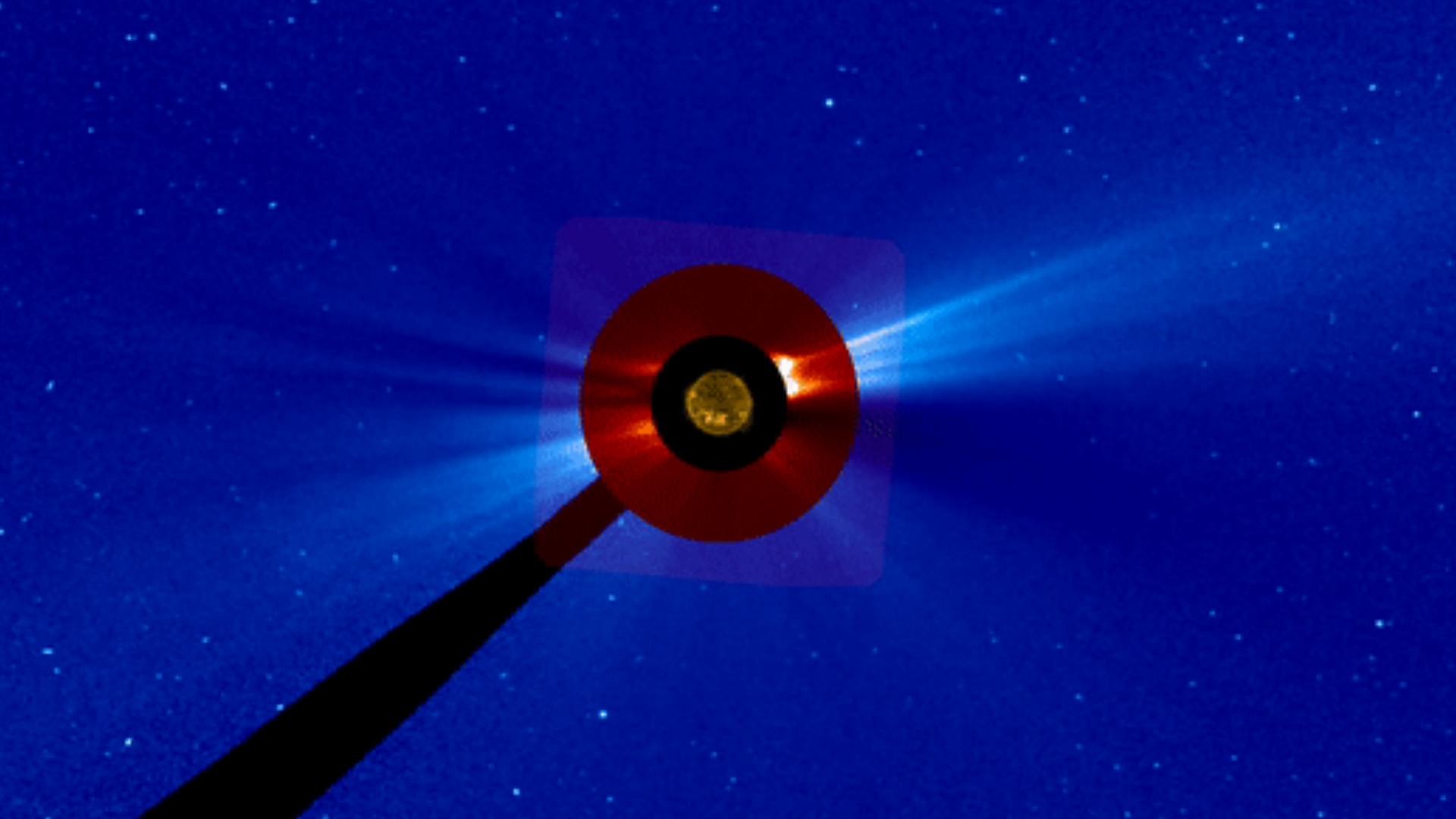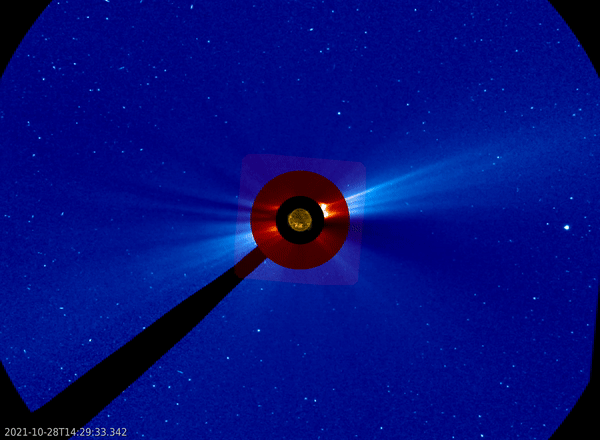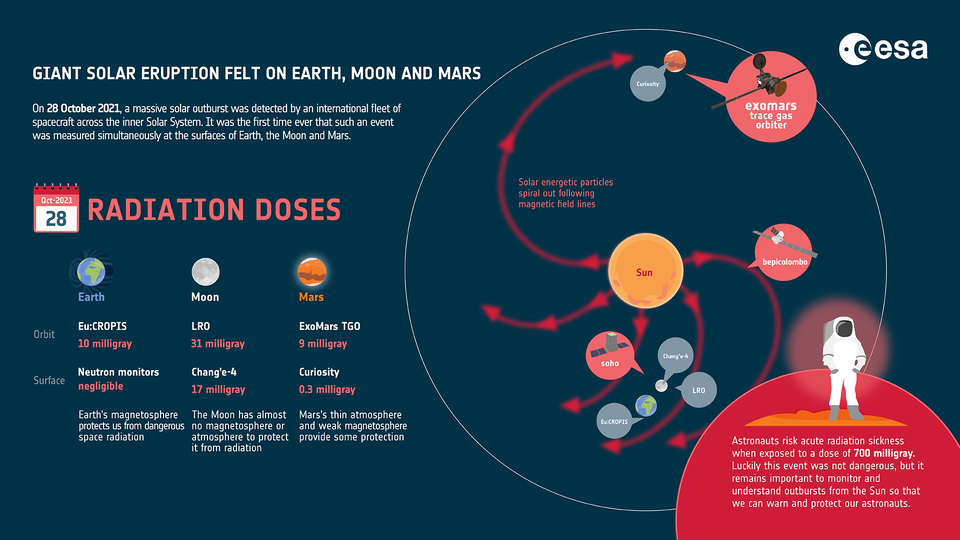1st solar eruption to simultaneously impact Earth, moon and Mars shows dangers of space radiation
A 2021 coronal mass ejection sent energetic particles to Mars, the Earth and the moon, emphasizing the need to prepare human space missions for the dangers of solar radiation.

A solar eruption that occurred in Oct. 2021 was simultaneously detected here on Earth, on the moon — and even on Mars.
By detecting the same coronal mass ejection (CME) on these three different worlds for the first time, scientists can better determine how a planet's magnetic field and atmosphere work together to shield life from such radiation.
This first-of-its-kind CME detection was made even more impressive by the fact that at the time of the eruption, our planet and the Red Planet were on opposite sides of the sun with a gulf of around 155 million miles (250 million kilometers) between them.
The outburst was detected by the ExoMars Trace Gas Orbiter (TGO) on Mars, by the Chang'e-4 Moon lander and NASA's Lunar Reconnaissance Orbiter (LRO) on the lunar surface and by the Euglena and Combined Regenerative Organic-Food Production in Space (Eu:CROPIS) orbiter around Earth.
Related: A long solar flare just erupted from the sun and the video is stunning
This CME caused an influx of highly energetic, and thus fast-moving, charged particles across the surface of these solar system bodies. And in the process, it demonstrated the need to protect human space exploration missions against the dangers of space radiation.
"Space radiation can create a real danger to our exploration throughout the solar system," ExoMars TGO project scientist, Colin Wilson, said in a statement. "Measurements of high-level radiation events by robotic missions is critical to prepare for long-duration crewed missions. Thanks to data from missions like ExoMars TGO we can prepare for how best to protect our human explorers."
Get the Space.com Newsletter
Breaking space news, the latest updates on rocket launches, skywatching events and more!

Solar eruptions on different worlds
Usually, charged particles hit the magnetosphere, a magnetic bubble around Earth, then travel down magnetic field lines and disperse beyond our planet. What this means is that Earth's natural magnetic field shields life from this solar radiation.
According to the European Space Agency (ESA), the CME that erupted on Oct. 28, 2021 is an example of a rare event called a "ground level enhancement," during which charged particles from the sun travel fast enough to penetrate the magnetosphere and reach the ground. This is just the 73rd example of such an event since records began in the 1940s, and it remains the last to be recorded.
On the other hand, Mars and the moon both lack a magnetic field. This means charged solar particles can strike their surfaces more often than on Earth. When this happens, it generates what's known as secondary radiation from the surface of these worlds. It's worth noting that Mars still has an atmosphere that, while much thinner than Earth's, can still stop low-energy particles and slow high-energy particles.
With both Mars and the moon being hotspots for future crewed space exploration, it is vital to know how both locations are impacted by solar radiation and, thus, what humans might experience on the surfaces of those worlds if astronauts embark on long-term missions there someday.
One of the adverse effects of radiation absorption is radiation poisoning, which arises due to damaged bone marrow and can trigger symptoms such as infection and internal bleeding. This can be caused by a radiation dose over 0.7 Gray (Gray is the metric for radiation absorption). If an astronaut absorbs over 10 Gray they would likely be dead within 14 days.
In August 1972, a solar outburst occurred that would have delivered precisely such a high dose of radiation to an astronaut if one had been on the moon at the time — but fortunately, it happened between the crewed Apollo 16 and Apollo 17 missions.

The LRO measured the radiation delivered by the Oct 2021 outburst to the moon's vicinity as substantially less than a lethal dose, however, at just 0.031 Gray.
“Our calculations of the past ground-level enhancement events show that on average one event every 5.5 years may have exceeded the safe dose level on the moon if no radiation protection had been provided," University of Science and Technology of China astrophysicist, Jingnan Guo, who researched the event, said in a statement. "Understanding these events is crucial for future crewed missions to the surface of the Moon."
Measurements taken in orbit around Mars by ExoMars were 0.009 Gray, while at the surface of the red planet, the Curiosity Rover measured just 0.0003 Gray. That means even the thin atmosphere of Mars reduced potential radiation absorption by approximately 30 times.
The CME was also caught by the ESA inner solar system missions including the Solar Orbiter, SOHO and BepiColombo. This gave scientists even more vantage points from which to study it.
"Currently, we live in a golden age of solar system physics," ESA research fellow, Macro Pinto, who was not involved in the research but helps develop radiation detectors for the space agency, said. "Radiation detectors aboard planetary missions such as BepiColombo, on its way to Mercury, and Juice, cruising to Jupiter, add a much-needed coverage to study the acceleration and propagation of solar energetic particles."
The team's research is published Wednesday (Aug. 2) in the Geographical Research Letters.
Join our Space Forums to keep talking space on the latest missions, night sky and more! And if you have a news tip, correction or comment, let us know at: community@space.com.

Robert Lea is a science journalist in the U.K. whose articles have been published in Physics World, New Scientist, Astronomy Magazine, All About Space, Newsweek and ZME Science. He also writes about science communication for Elsevier and the European Journal of Physics. Rob holds a bachelor of science degree in physics and astronomy from the U.K.’s Open University. Follow him on Twitter @sciencef1rst.
-
p3orion When Mars and Earth are on opposite sides of the sun, the distance between them would be about 235 million miles, not 155 million. I can't tell if the author was imprecise about the "opposite" or just wrong about the distance.Reply
Incidentally, a "Gray" (the unit supplanting the more familiar "rad" for radiation absorption) is equal to 100 rads, or 1 joule per kilogram. -
Unclear Engineer Yes, the physicist society really set back the public's understanding of ionizing radiation and its biological effects when they insisted on changing the units from the centimeter-gram-second system to the meter-kilogram-second system, and giving them all new names.Reply
People don't realize how much radiation is given to them by medical procedures. And, the medical community seems to not consider the damage that their diagnostic practices can cause, not to mention their damage from some (illegal) events involving disabling safety systems intended to prevent overdoses or inadvertent doses.
For instance, I recently had surgery that necessitated scanning my skull multiple times. The problem was originally found with an MRI, which does not use ionizing radiation, but follow-ups were ordered with CAT scans, which give a dose of about 0.5 Gray (50 rads) to the exposed tissues. After 3 of those, I had to ask for a switch back to using the MRI, because a 4th CAT scan in that short time period would have reached the deterministic threshold of producing cataracts in my eyes within 8 years. If I had not spoken up, I would have had 2.5 Grays to my eyes by now, in a very short period.
Time period for delivery of the total dose is important when considering deterministic effects like cataracts, radiation sickness, and death. Probabilistic effects, such as cancer initiation, are considered time-independent with respect to how long the time period was when the dose was delivered, although there is a delay period used to associate the dose to the effects in data analysis. The difference is that the deterministic effects are considered to be caused by damage that the body can repair and recover from, while probabilistic effects at lower doses are considered to be damage to things like genetic material that cannot be repaired. However, the corneas of the eyes are biologically isolated systems with respect to fluid circulation, so repair is not expected there, and the dose that causes deterministic effects is therefore lower than in other tissues. So, for radiation to the head, the allowable doses are controlled by the eyes. For CAT scans to other areas of the body that do not expose the head to the radiation beam, the allowable total doses can be higher. And, spreading out the doses over time can allow for higher totals, as well.
Relating this to space travel, there is the concern that an event causing rapid dose delivery, such as being in the path of a solar flare emission, could quickly disable a crew of astronauts during their mission. However, the same dose over a multi-year mission would not have those deterministic effects. But, for both situations, the total dose would have some probability of causing delayed sicknesses or deaths years after the missions were completed. Those probabilistic effects are considered to have a probability that increases linearly with the total dose. That is often argued to not be true, but it is a reasonable approximation for computing risks to the astronauts in the dose ranges that are being considered.
As with medical decisions to use x-rays, the question for space travel is whether the potential gain is worth the risk. Determining both the risks and the benefits are not exact science, even though we try to compute numbers for some of the effects. -
Pogo As a naval nuc plant operator in the early 1970s, I’m still accustomed to REM radiation doses.Reply -
Unclear Engineer Yes, divide REM doses by100 to get Sieverts.Reply
I suspect there was some politics involved in the choice to adopt the MKS units instead of the cgs units. Doses just sound better when they are measured in fractions of a unit instead of tens of units. So, even "milliGrays" are not so bad sounding for most radiation workers. And, doctors are talking about tenths of Grays instead of tens of rads.
Still it is a bit disconcerting to take the ratio of what a radiation worker is allowed to the amount that a medical diagnostic scan delivers. One CAT scan of my head gave me 10 years of dose limits for a radiation worker's head. -
Pogo I do remember high school physics at which we used cgs, later it was changed to MKS. I still think of c in terms of cm/sec, then have to think MKS and divide by 100.Reply









